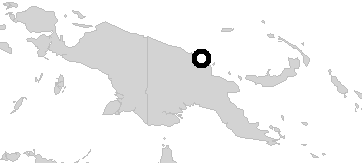
| www.CuriousTaxonomy.net |
|
The Flood in World Myth and Folklore
New Guinea |
| © 2021 Mark Isaak |

The men of the village went to hunt pig. Duongangwongar, a peculiar man and a nonconformist, went with them. Where other failed, he succeeded in wounding a pig. The others came at his cries and helped to finish off the pig. As each man withdrew his spear from the pig, he plunged it into Duongangwongar. They left his body on a small hidden platform and returned to the village, claiming not to know where Duongangwongar was.
That night, Duongangwongar's mother Gundakar had a dream in which her son showed the location of his body. Aided by Duongangwongar's spirit in the form of a little bird, she soon found the body. She carried it back for burial, but village after village refused her. Finally at the coastal village of Dogoi a friendly man helped Gundakar bury her dead son. They married and had a son.
One day, Gundakar went by her son's grave to get water. Drawing aside the coconut fronds, she found salt water and fish coming from Duongangwongar's nostrils. She used some that water to cook the evening meal, and her husband and son enjoyed it. That night, Gundakar's son grew tremendously. The next day, when Gundakar flung scraps of the previous evening's taros, yams, and mami into the garden plot, they miraculously grew into new tubers.
Gundakar took a small fish from Duongangwongar's grave and cooked it for her husband and son. That night, the son grew into a man.
The husband's younger brother was so astounded at the change that he demanded to know how it had happened. Gundakar told his wife about Duongangwongar's grave, saying, "Take some water from his nostrils and take one small fish. You will see other larger fish, but take only one small fish."
The younger brother's wife went to the grave, drew aside the coconut fronds, and, seeing a large fish, speared it. Immediately a torrent issued from his nostrils, creating a sea between the two brothers, who had fled in different directions.
Later, the younger brother killed and cooked a small bird and threw its bones into the sea. There was a soft sound like water running over pebbles. By doing the same with increasingly larger birds, he caused the surf to tumble on beach.
Wondering about his elder brother, the younger brother threw a leaf upon the waters. The leaf floated to his elder brother, who had found refuge on high ground. The elder brother recognized the leaf as a message from his brother and sent it back.
Later, the younger brother made a dugout canoe and went to visit his brother. The elder brother marveled at this invention; later he copied it and visited his younger brother. The younger brother then made a boat, which his elder brother again copied when he saw it. The younger brother went on to make a motor car, a motor bike, a large steamship, an airplane, canned good, cloth, and many other things. Each time he did so, his elder brother copied him.
Kenelm Burridge, Mambu: A Melanesian Millennium (London: Methuen & Co., 1960), 154-160; variants, 160-165; also in Kenelm O. L. Burridge, "Social Implications of Some Tangu Myths", in: Myth and Cosmos, ed. John Middleton (Garden City, NY: The Natural History Press, 1967), 30-38.
